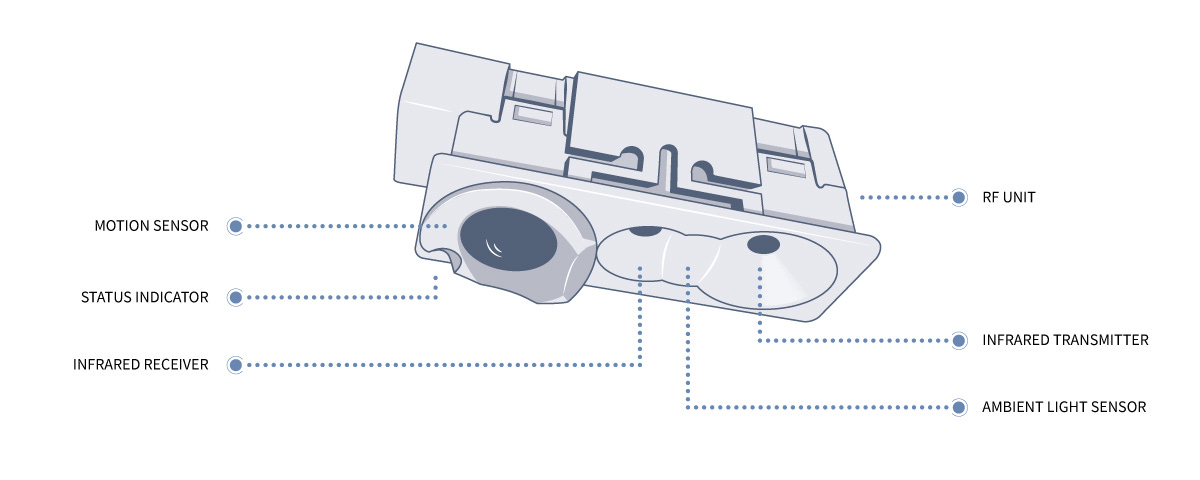If you are anything like me, every time you are first in the office and turn on the light switch and every fixture in the whole room turns on, you feel a little annoyed and ask yourself why?
So much energy is used to light up space that doesn’t really need it. In a computer game, a big part in optimizing performance in 3D games is only letting the graphics processing unit compute what is visible to the player’s eyes, the same principle could be used for lighting up your office space. This week’s company provides the technology that lets you do just that.
👽 What?
OR Technologies’ flagship product, called Organic Response, is a sensor module, that is integrated into light fixtures, so it can be combined into a peer-to-peer wireless network of light. This means that the sensors can communicate with each other directly, and it removes the need of relying on an external control system like the good old-fashioned light switch or more advanced wired communication systems.
The motion sensors, together with the ambient light sensors that are part of the system act as a trigger and can be programmed to act a certain way depending on the use of the room. The way to program this is called personality, and it indicates the way the hardware reacts to motion. For example, the “super saver” mode only illuminates the fixtures that are closest to motion fully and leaves the lights that are further away turned off. It’s hard to explain the concept, and that’s why they've built a demo application showing the capabilities of the different personalities.
Of course, the behavior can be overridden by the users, in this case not with a switch, but by using a mobile phone application.
imagery courtesy OR Technologies
As a by-product, becoming an increasingly more important capability, Organic Response also provides a cloud portal transforming the system into a real-time analytics platform, not unlike VergeSense.
They provide an IoT Gateway that allows the system to interface with other systems in the building like your BMS, or with other cloud applications via the Organic Response API.
🤷 Who?
OR Technologies, originally named Organic Response, is an Australian company and was founded by Danny Bishop and Chris Duffield in 2011. They quickly gained some traction and partnered up with E.ON to expand outside Australia. The companies’ technology was incorporated into products from Feilo Sylvania, Koopman Interlight, and Fagerhult. In 2017 the company became insolvent and was acquired by the Swedish multinational Fagerhult.
🕵️♀️ Who else?
Even though the Organic Response solution feels very innovative, the number of different types of lighting control systems on the market is mind-boggling. Only looking at the different types provided by Fagerhult one might feel bewildered. So it’s hard to say whether the “personality” technology is really so unique, or it’s just hard to find competitors in the sea of lighting control options.
However, the approach of integrating wirelessly networked integrated sensors into individual light fixtures, sometimes called Luminaire Level Lighting Controls or LLLC, is definitely a trend in the industry.
Another notable provider in this regard is Silvair, they provide Bluetooth mesh lighting systems, this solution also provides an easily adaptable lighting solution, but additionally, they also render energy consumption insights.
👍 Why
OR technologies claim that the organic response lighting system can be up to 75% more energy efficient than normal LED lighting, and as such reduce the cost of managing the building.
By overcoming the need for control wiring the system is easy to install, even when retrofitting a building. Once installed It gives extra flexibility to building owners to adapt their buildings to changing needs or usage patterns without the need to rewire anything.
Having an API for the lighting in your building opens up a ton of possible future solutions that can be added by third parties like e.g. wayfinding.
👎 Why not?
A light switch is indeed a not very creative way to control your lighting, but it’s a universally known user interface and in contrast to using presence as a trigger at least, it provides a clear intention of lighting up the room. Having the switches replaced by smartphone applications instead of being an addition might not always be the most optional solution.
The quality of the presence detection is a big point of attention, even though having to move to keep the lights on might be a good way to keep fit, it almost always is a terrible experience.
📚 Further reading?
Luxreview: Fagerhult steps in to save OR
The Fifth Estate: Organic Response international ambitions
LLLC: The Future of Efficient Lighting
✨ Giphty
Bye bye light switch!




